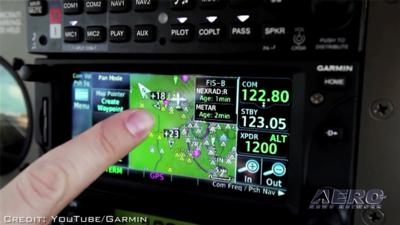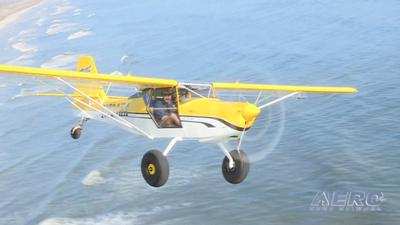Working With Industry On Several Initiatives To Make Flying Safer
The FAA and industry are working on a number of key initiatives to improve general aviation (GA) safety: the GA Joint Steering Committee (GAJSC), Equip 2020 for ADS-B Out, new Airman Certification Standards (ACS), streamlining aircraft certification, the Got Data? External Data Initiative, and the Fly Safe outreach campaign on Loss of Control.

The United States has the largest and most diverse GA community in the world, with more than 220,000 aircraft, including amateur-built aircraft, rotorcraft, balloons, and highly sophisticated turbojets. By working together, and focusing on data driven solutions, government and industry are making a difference to put the right technologies, regulations, and education initiatives in place to improve safety.
The FAA’s goal is to reduce the GA fatal accident rate by 10 percent over a 10-year period (2009-2018). Inflight loss of control – mainly stalls – accounts for the largest number of GA fatal accidents. Although the fatal accident rate is beginning to decline, last year (FY17) 347 people still died in 209 general aviation accidents.
The FAA and industry are focused on reducing general aviation accidents by primarily using a non-regulatory, proactive, data-driven strategy to get results— similar to the strategy the FAA uses in commercial aviation.
Using data, the FAA and industry are working together to identify risk, pinpoint trends through root cause analysis, and develop safety strategies. The FAA and the GA community carry out this work through the GAJSC. Formed in the mid-1990s, the GAJSC recently has renewed its efforts to combat GA fatal accidents. The government and industry group uses the same approach as the Commercial Aviation Safety Team (CAST). It uses a data-driven, consensus-based approach to analyze safety data to develop specific interventions that will mitigate the root causes of accidents.
Recent accomplishments include more than 39 safety enhancements, (such as training, procedures, and technology) to address loss of control. Examples include a streamlined policy for angle of attack (AOA) system approvals and outreach to the GA community on loss of control topics.With powerplant system and component failures being the third leading fatal GA accident category, the GAJSC analyzed fatal GA accidents involving total or partial engine power loss. The GAJSC approved and initiated implementation of ten SEs directed at engine issues and focus on improving engine technology, aiding the pilot in decision making post-engine failure, and improving resources available to mechanics, as well as their education and training.
The GA JSC began its study into Controlled Flight Into Terrain (CFIT) accidents in October 2017 and will finish its work sometime in 2018. CFIT is the second largest risk in GA. The GAJSC combines the expertise of many key decision makers across different parts of the FAA, several government agencies, and stakeholder groups. The other federal agencies are the National Aeronautics and Space Administration and the National Transportation Safety Board (NTSB), which participates as an observer. Industry participants include the Aircraft Owners and Pilots Association, Experimental Aircraft Association, General Aviation Manufacturers Association, Light Aircraft Manufacturers Association, National Business Aviation Association, National Air Transportation Association, National Association of Flight Instructors, Society of Aviation and Flight Educators, and the aviation insurance industry. The European Aviation Safety Agency (EASA) also participates as an observer.
Other achievements include several web-based resource guides, information on flying and medications, and overall GA community coordination on Loss of Control and engine issue topics. Resources include targeted themes and articles in the FAA Safety Briefing magazine.
The GA community and the FAA are moving toward using de-identified GA operations data in the Aviation Safety Information Analysis and Sharing (ASIAS) program to help identify risks before they become accidents. In March of 2014 the FAA started a one-year project to illustrate the value, capabilities, and benefits of the ASIAS program for the GA community. The project explored potential new information sources such as General Aviation Flight Data Monitoring, voluntary safety reports, manufacturer reports, and information collected from avionics and using new common technologies such as iOS and Android personal electronic devices.
This project led to a broader expansion of GA in ASIAS. Tools are now available to the GA community to help explore and understand their own flight data and look for potential risks. Through this program, the FAA does not have access to any individual pilot’s data as the system is hosted by a third party. The de-identified aggregate data is used by the GA community through ASIAS to identify trends and look for system risks that may need to be mitigated. Data from these programs will be used for GA JSC initiatives and research conducted by the GA community. The GAJSC is working with the community to incorporate their data into ASIAS so that it may be used to identify risk.
The NextGen program includes innovative technologies and procedures to make flying safer, greener, and more efficient. In March 2015, the FAA achieved a major milestone by completing one of the largest automation changeovers in the history of the agency: a new high-altitude air traffic control system, known as En Route Automation Modernization (ERAM). This system will accommodate the technologies of NextGen, giving the U.S. a more powerful air traffic system.
The FAA is working with manufacturers to define equipage requirements and support NextGen by streamlining the certification and installation of NextGen technologies, such as Automatic Dependent Surveillance-Broadcast (ADS-B). It is a foundation of NextGen and transforms aircraft surveillance using satellite-based positioning.

ADS-B enhances GA pilots’ awareness of other traffic and improves safety in areas that radar cannot reach, such as Alaska and the Gulf of Mexico. Pilots flying properly equipped aircraft can see graphical weather information on cockpit displays, where they are in relation to nearby aircraft, and flight information such as temporary flight restrictions. The full benefits of ADS-B can only be realized if all of the planes that fly in controlled airspace are equipped. The FAA has set January 1, 2020, as the deadline to equip for ADS-B Out in controlled airspace. DOT and the FAA offered a $500 rebate incentive for GA aircraft owners who equip their aircraft with required avionics technology. Accelerating compliance is critical to ensuring that pilots, manufacturers, and retail facilities have adequate time and capacity to equip aircraft in a timely and efficient manner, ahead of a 2020 regulatory deadline. Although the agency is no longer accepting new rebate reservations, owners who have an
existing reservation should complete the final steps.
In collaboration with aviation training community experts, the FAA has updated key elements of the airman certification system to include an enhanced focus on risk management. In June, the FAA replaced the Practical Test Standards (PTS) for the Private Pilot certificate in the airplane category and the Instrument Rating (also in the airplane category) with the corresponding Airman Certification Standards (ACS).
The ACS improves the PTS by adding task-specific knowledge and risk management elements to each PTS Area of Operation and Task. By integrating knowledge and risk management requirements with skill tasks, the ACS offers a comprehensive presentation of the standards for what an applicant needs to know, consider, and do in order to pass both the knowledge and practical tests for a certificate or rating. This format helps applicants, instructors, evaluators, and other stakeholders understand what the FAA expects in each phase of the certification process, from the FAA knowledge exam to the practical test. It also helps everyone understand how knowledge, risk management, and skill work together for safe operation in the NAS.
In 2016, the FAA launched the Got Data? External Data Access Initiative to give the private sector better access the FAA’s aeronautical data and spur innovation. The goal is to help industry be in a position to create innovative products and technologies that improve safety and efficiency. The initiative includes data such as airports, navigation aids, fixes, obstacles, holding, approaches, and Temporary Flight Restriction information. Based on stakeholder feedback, the FAA is delivering new features such as the Data Innovation Center, geofenced aeronautical chart product data in consumable formats, and automated digital product downloads. The FAA has also expanded the digital Terminal Procedures Publication, Coded Instrument Flight Procedures, the 8620-2 for all fixes, and added new symbology to charts.

On August 30, 2017, a final rule overhauling airworthiness standards for general aviation airplanes officially went into effect. The FAA expects this rule will enable faster installation of innovative, safety-enhancing technologies into small airplanes, while reducing costs for the aviation industry. These performance-based standards implement forward-looking, flexible rules that encourage innovation. Specifically, the rule revolutionizes standards for airplanes weighing 19,000 pounds or less and with 19 or fewer passenger seats by replacing prescriptive requirements with performance-based standards coupled with consensus-based compliance methods for specific designs and technologies. The rule also adds new certification standards to address GA loss of control accidents and in-flight icing conditions.
The rule addresses recommendations presented in 2013 by a 55-member rulemaking committee that included representatives from the FAA, European Aviation Safety Agency, National Civil Aviation Agency of Brazil, Civil Aviation Administration of China, Transport Canada, Civil Aviation Authority of New Zealand, several airplane and avionics manufacturers, and industry groups.
On March 31, 2016, the FAA published a new policy to help aircraft owners voluntary install safety equipment on airplanes and helicopters that is not required by the agency’s regulations. It will reduce costs and streamline the installation of Non-Required Safety Enhancing Equipment (NORSEE) into the general aviation fleet.The policy is the result of collaboration under the GAJSC and expands the 2014 FAA policy, which simplified the design approval requirements for a cockpit instrument called an angle of attack (AOA) indicator. AOA devices can be added to small planes to supplement airspeed indicators and stall warning systems, alerting pilots of a low airspeed condition before an aerodynamic stall occurs. Such stalls are particularly dangerous during takeoff and landing.
NORSEE includes avionics, electronic instruments, displays and mechanical equipment. Equipment approved as NORSEE increases overall situational awareness; provides additional information other than the aircraft primary system; provides independent warning, cautionary, or advisory indications; and provides additional occupant safety protection. Examples of NORSEE equipment include: traffic advisory systems, terrain awareness and warning systems; attitude indicators; fire extinguishing systems; and autopilot or stability augmentation systems. The policy has the flexibility to accommodate the installation of new technology safety enhancements into Part 23, 27, and 29 aircraft that are determined to be a minor change to type design. The benefits must outweigh the risk. The policy will reduce equipment costs by allowing the applicants the flexibility to select various industry standards that suit their product, as long as it meets the FAA’s minimum design requirements. NORSEE approval under the
policy is not an approval for installation on the aircraft – it just makes the equipment eligible for installation on the aircraft.
On February 5, 2014, the FAA took an important step to help improve safety in small aircraft by simplifying design and production approval requirements for an AOA indicator. AOA indicators provide the pilot with a visual aid to prevent loss of control of the aircraft in the critical phases of flight. Previously, cost and complexity of indicators limited their use to the military and commercial aircraft. Under new FAA guidelines, AOA devices can be added to small airplanes to supplement airspeed indicators and stall warning systems, giving pilots an additional tool to avoid a dangerous aerodynamic stall and subsequent loss of control. The FAA continues to work to improve RVSM Letter of Authorization (LOA) process.
The FAA has partnered with the International Helicopter Safety Team (IHST) and the U.S. Helicopter Safety Team (USHST) to promote safety and reduce civil helicopter accidents and fatalities worldwide. The IHST was formed in 2005 to lead a government and industry cooperative effort to address factors that were contributing to an unacceptable helicopter accident rate. Prior to 2006, the number of worldwide civil helicopter accidents was rising at a rate of 2.5 percent per year. Since 2006, the worldwide civil helicopter fleet has grown by 30 percent but the number of accidents has decreased in key global regions by 30 to 50 percent.
IHST members establish partnerships with countries with significant helicopter operations and encourage overseas industries to perform accident analysis and develop safety interventions. Partners include government and industry participants from the United States, Canada, Brazil, Mexico, New Zealand, India, Russia, and multiple countries in Europe, Central Asia, and the Middle East.
Since its creation as a regional sub-team of the IHST in 2013, the USHST has focused on the U.S. civil helicopter community and especially on fatal accidents. Comparing 2016 to 2013, the U.S. civil helicopter industry experienced a 30 percent accident rate reduction, from 4.95 accidents per 100,000 helicopter flight hours to 3.45 accidents per 100,000 helicopter flight hours. In addition, the number of fatal accidents has been cut nearly in half and the fatal accident rate is down 47 percent compared to 2013.
In 2017, the USHST completed an extensive analysis of fatal accidents using the same approach as the CAST and the GAJSC. The analysis focused on the three occurrence categories that contributed to the most fatal helicopter accidents from 2009-2013: loss of control – inflight (LOC-I), unintended flight into IMC (UIMC), and low altitude operations (LALT). The team developed 22 Safety Enhancements to be implemented by the industry and the FAA. The Safety Enhancements address technology, simulation, risk management, and outreach solutions in the effort to reduce fatal accidents.

Amateur-built and other experimental aircraft were involved in almost 25 percent of U.S. fatal general aviation accidents over the past five years and account for an estimated five percent of total general aviation fleet hours. With the help of targeted safety enhancements developed by the FAA and GAJSC industry participants, and new policies, this segment of the GA industry is showing significant improvement.
Loss of control remains the leading cause of fatal accidents involving amateur-built aircraft. The FAA’s Airmen Transition to Unfamiliar Airplanes Advisory Circular (AC 90-109A) helps plan the transition to any unfamiliar fixed-wing airplanes, including type-certificated (TC) and/or experimental airplanes. It provides information and guidance to owners and pilots of experimental, simple, complex, high-performance, and/or unfamiliar airplanes. It also provides information to flight instructors who teach in these airplanes.
The FAA also continues to promote AC 90-116, Additional Pilot Program (APP) for Phase I Flight Test. The AC provides information and guidance for flight testing experimental aircraft. The APP was developed to improve safety by enhancing Builder/Owner Pilot (BP) skills and mitigate risks associated with Phase I flight testing of aircraft built from commercially produced kits through the use of a qualified additional pilot and powerplant testing. The APP is an optional program which provides another pathway to conducting Phase I flight testing. The traditional option for a pilot to test their aircraft solo during Phase I is not covered or affected by this AC, and remains an option for those who choose to do so in accordance with their aircraft’s operating limitations.
Working through the Aviation Accreditation Board International (AABI) and the University Aviation Association (UAA), the FAA is partnering with the aviation academic community to leverage their expertise and develop best practices for improving flight training.
(Source: FAA. Images from file)
 Affordable Flying Expo Announces Industry MOSAIC Town Hall
Affordable Flying Expo Announces Industry MOSAIC Town Hall Classic Aero-TV: Composite-FX Sets Elevates the Personal Helicopter Market
Classic Aero-TV: Composite-FX Sets Elevates the Personal Helicopter Market Aero-News: Quote of the Day (10.25.25)
Aero-News: Quote of the Day (10.25.25) ANN's Daily Aero-Term (10.25.25): Ground Stop (GS)
ANN's Daily Aero-Term (10.25.25): Ground Stop (GS) NTSB Final Report: Gallow Daniel A Kitfox Classic IV
NTSB Final Report: Gallow Daniel A Kitfox Classic IV






